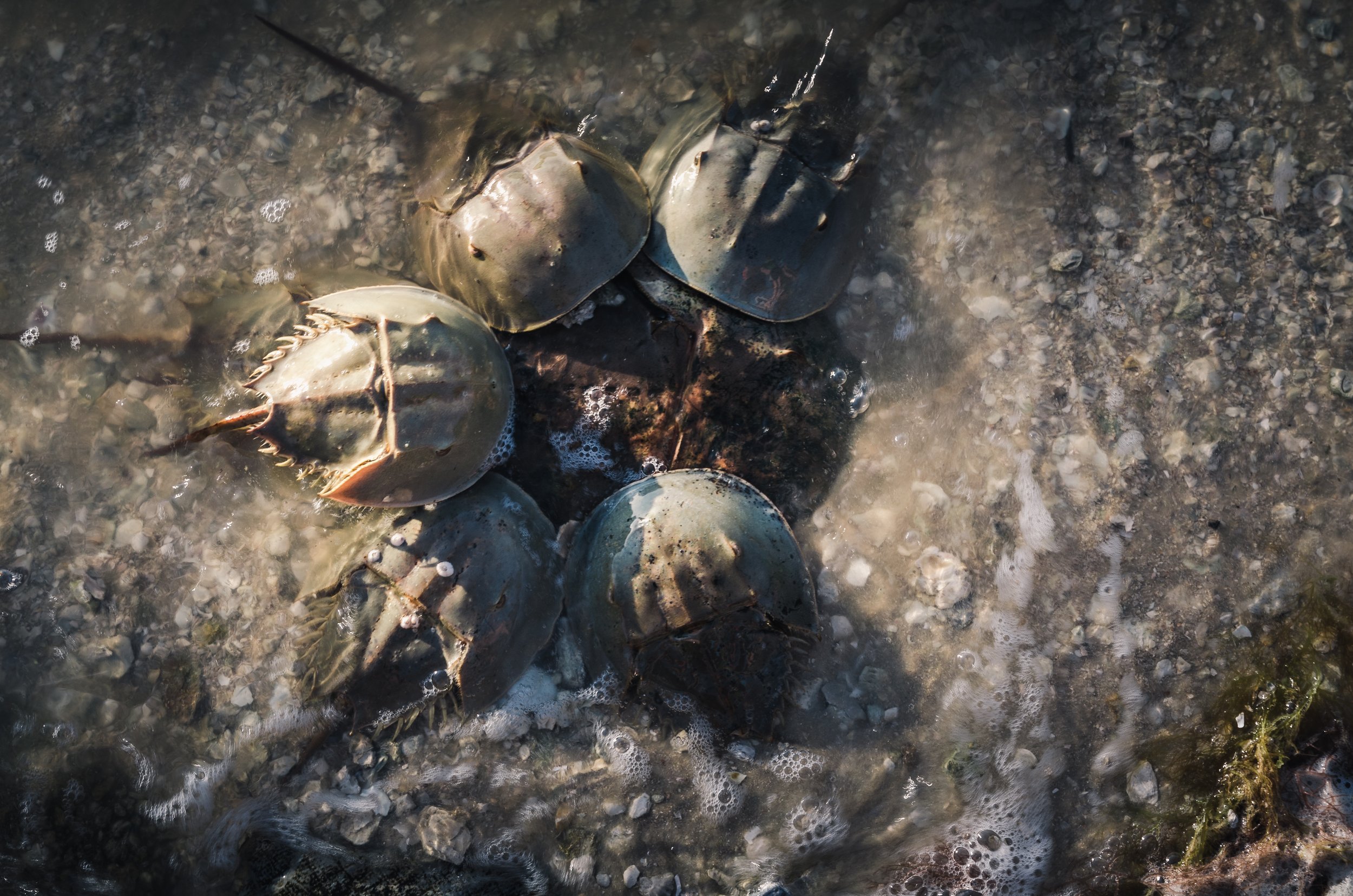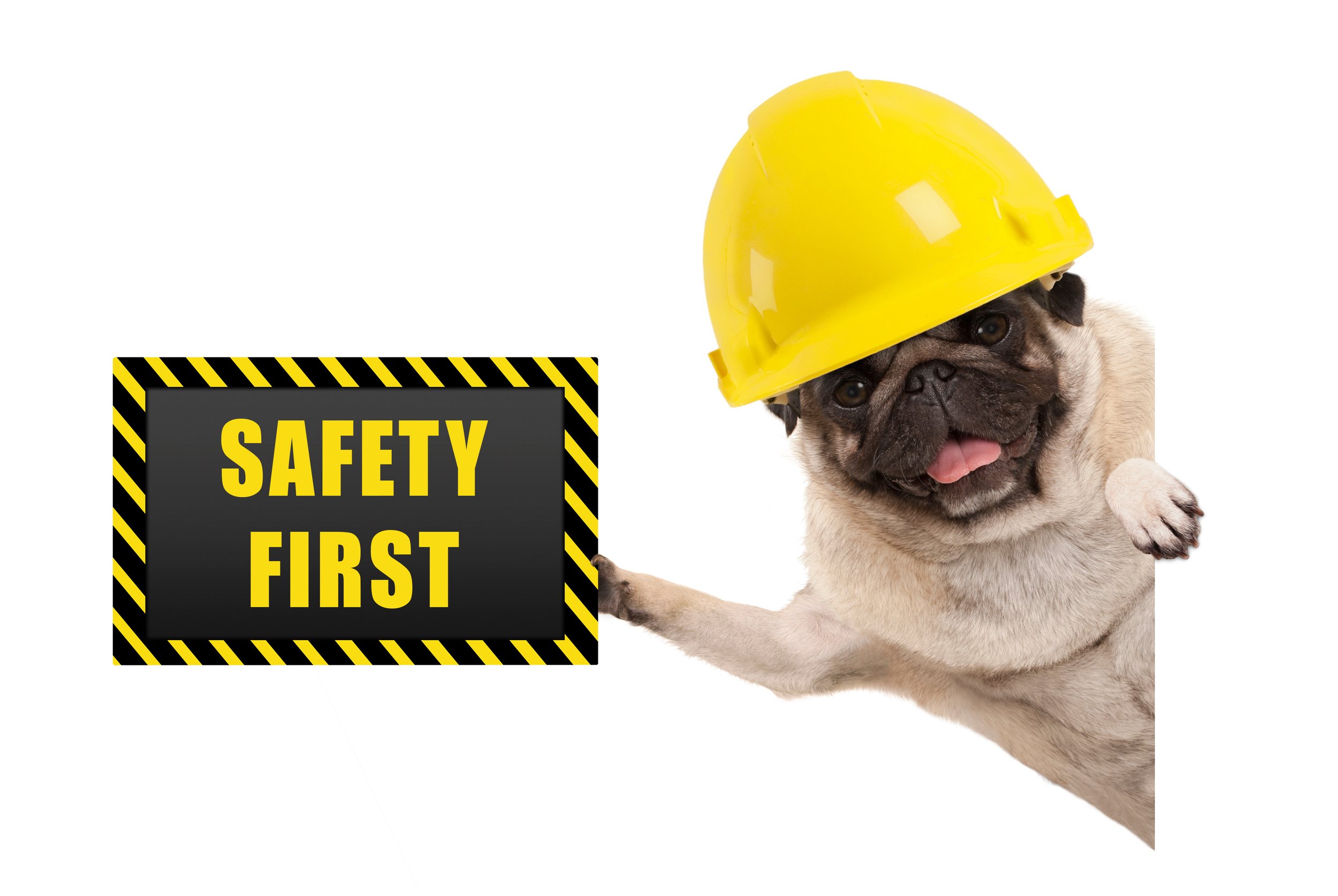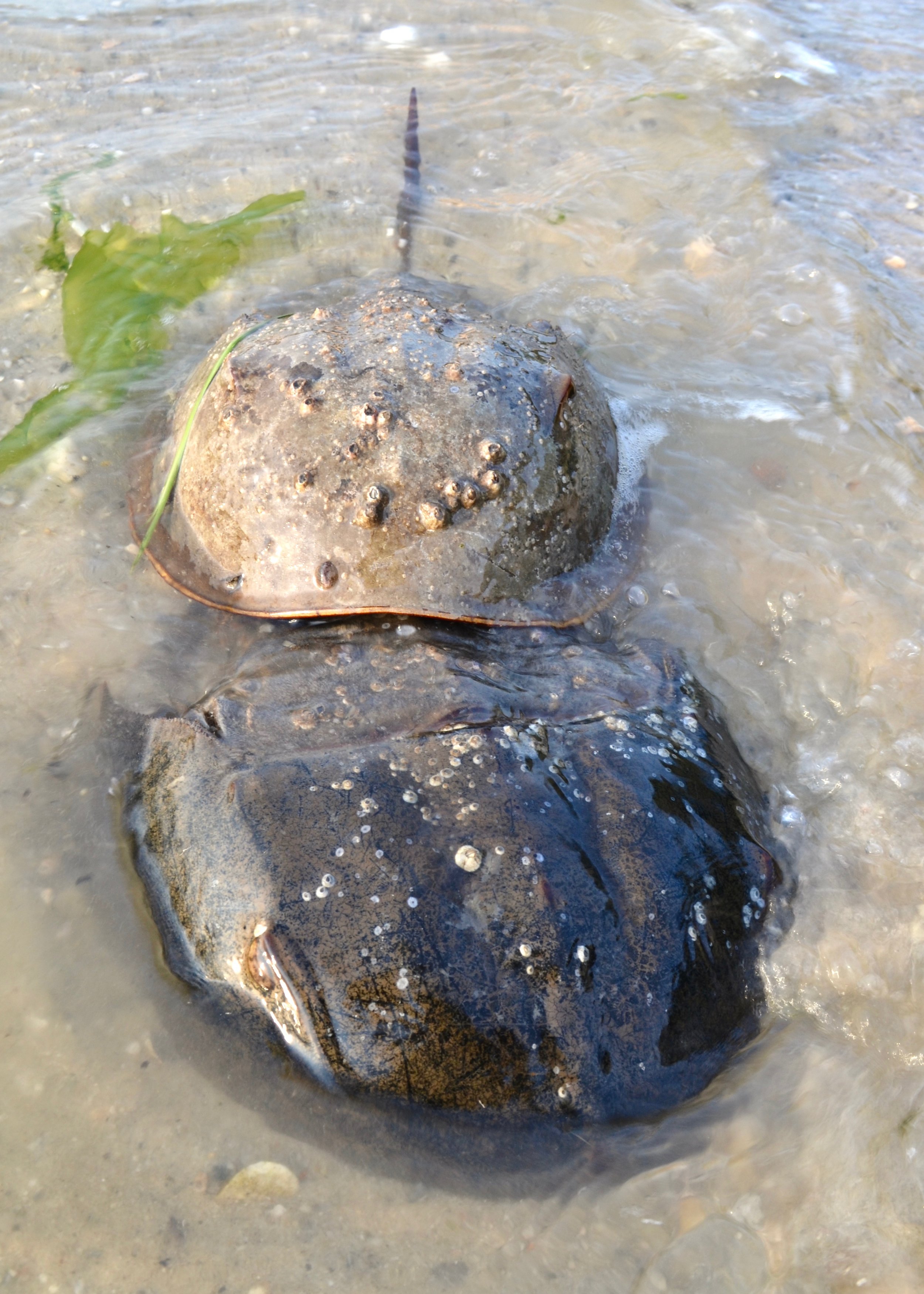MONITOR HORSESHOE CRABS ALONG SANDY HOOK BAY AND RARITAN BAY, NJ
Video by Gavin Shwahla: www.gavinwild.com
Join volunteers with Save Coastal Wildlife (SCW) Nonprofit to help Collect Valuable Data on Horseshoe Crab Populations along the shores of Raritan Bay and Sandy Hook Bay, NJ.
Horseshoe Crab Monitoring
American or Atlantic Horseshoe Crab
(Limulus polyphemus)
Since 2009, volunteers with Save Coastal Wildlife have been monitoring the spawning activity of horseshoe crabs along the northern Jersey Shore.
Volunteers walk a bayside beach at several sites during the same time on full moon and new moon evenings in May & June to count the number of crabs present. Volunteers also tag single male and female crabs to keep track of their whereabouts and movements within New York - New Jersey Harbor Estuary as part of our ongoing efforts to understand the the mysterious life of a 400 million+ old species, an ancient mariner on this Blue Planet.
It’s exciting work that is contributing to long-term research and helping people better understand and protect horseshoe crabs, especially those that live in urban-suburban waters along the east coast of the United States.
Save Coastal Wildlife is working with the U.S. Fish and Wildlife, the National Park System, and New Jersey Department of Environmental Protection, Division of Fish and Wildlife, to receive permits and implement this project.
Save Coastal Wildlife is the largest and longest serving organization monitoring horseshoe crabs along the shores of Sandy Hook Bay and Raritan Bay in New Jersey.
All Horseshoe monitoring activities are sent via email!
All volunteers are required to fill out the volunteer waiver Form before starting the project.
Volunteer
We need interested and thoughtful people to help count and tag horseshoe crabs. No prior experience is necessary.
Volunteers will be trained to record the number and sex of spawning horseshoe crabs and report sightings of tagged horseshoe crabs. The information collected is important in monitoring populations to help protect this important estuarine species in New Jersey.
Please make sure you are signed up to receive emails from Save Coastal Wildlife Nonprofit to learn how to participate in horseshoe crab volunteer monitoring training in April, May & June.
2025 Monitoring Dates & Times
Sunday, April 27 starting at 8:30pm
Monday, May 12 starting at 8:30pm
Tuesday, May 27 starting at 9:00pm
Wednesday, June 11 starting at 9:00pm
Wednesday, June 25 starting at 8:30pm
Please note that pre-registration is required to volunteer to monitor horseshoe crabs at all sites for the above specific dates & times. Registration information will be sent out to volunteers via email usually a week before each individual monitoring event.
There are limited spots available to monitor horseshoe crabs and they do fill quickly. Please register early.
Dates and times are subject to cancellation due to weather or public health safety issues.
Current Monitoring Locations
1. Plum Island At Sandy Hook
Address: Parking Lot B, Hartshorne Road, Highlands, NJ 07732. Volunteers please meet at Parking Lot B near the Bathroom Pavilion at Sandy Hook National Recreation Area. Parking Lot B is the first major parking area on your right as your enter the park pass the toll booths. Beach Captains: Sara Genke, Clare Supple, and Nick Bernardo.
***Please arrive early to make sure the park is not closed when you arrive. Also, please put a note on your car dashboard window to let park rangers know you are monitoring horseshoe crabs at Plum Island so not to receive a ticket.
2. Many Mind Creek in the Borough of Atlantic Highlands
Address: Gravel parking lot near 10 Simon Lake Dr, Atlantic Highlands, NJ 07716.
Volunteers please meet in gravel parking lot at the end of First Avenue located on the side opposite the marina. Monitoring site is on the beach, either side of the mouth of the creek. Beach
Captains: Jenna Reynolds, Joe & Robin Sheridan and family, and Richie (father) & Abby (daughter) Hesterhagen and family.
3. Leonardo Public Beach in Middletown Township
Address: near 218 Beach Avenue, Leonardo, NJ 07737. Volunteers please meet on the beach near the parking lot at the end of Beach Avenue located near the NJ State Marina in the Leonardo section of Middletown Township.
Beach Captains: Linda Stehlik, Sarah Stewart, Karissa Trotter.
4. Keyport Harbor in the Borough of Keyport
Address: On-street parking near 50 Cedar Street, Keyport, NJ 07735. Volunteers please meet at the northern end of Cedar Street, located next to Cedar Street Park. Cedar Street can be accessed via 1st Street or Pine Street in the Borough of Keyport, not far from the Keyport/Union Beach border and Chingarora Creek. There is also a small parking lot on Pine Street, on the other side of the ball field for vehicle parking. Beach Captains: Kim Roselli, Lynne Kosobucki, Paul Rollinson.
5. Cliffwood Beach in Aberdeen Township
Address: Entrance to beach parking lot located near 625 Ocean Blvd, Keyport, NJ 07735. Volunteers meet inside the parking lot nearest the beach located on Ocean Blvd, situated on the border of Aberdeen Township and Old Bridge Township.
*** Please note that some access roads to this site via Cliffwood Beach (Aberdeen Township) may flood during high tide events. For safety, please access this site via Old Bridge Township from US Route 35 and Raritan Blvd and Ocean Blvd.
Beach Captains: Christine Balint, Frank Huza and Jenica Roffina.
6. Raritan Reach Beach in the City of South Amboy.
Address: 80 Raritan Reach Rd, South Amboy, NJ 08879. On Google Maps, this area is referred to as South Amboy Beach Parking Lot. The entrance to Raritan Reach is located off of John T. O’Leary Blvd. The parking lot is located near the water. If the lot is closed, please follow directions from the beach captains. BEACH CAPTAINS: Korie Vee, Douglas Scott, Kaylin Vee, and Sasha Kovalyon.
HORSESHOE CRAB COLLECTION DATA SHEETS
Basic Protocol to Monitor Horseshoe Crabs
****SAFETY****
The following safety precautions are in place:
Feel free to wear a face covering if you desire.
If you are sick, stay home.
Stay home if someone you currently live with is sick or not feeling well, or if a close family member, friend, or co-worker is sick.
VERY IMPORTANT: Never do anything you feel uncomfortable, unsure, or confused.
ALWAYS THINK SAFETY FIRST!
Watch where you step! Sometimes female or mating horseshoe crabs bury themselves deep in the sand while laying eegs.
Volunteers under the age of 18 must be accompanied by an adult. Children, scouts, or students under the age of 18 must be accompanied by a parent, teacher, scout leader, or a legal guardian.
NO RUNNING!! Especially in the dark. Take your time. Please be mindful of large rocks, bricks, buckets, driftwood and other objects on the beach that might cause you to trip and fall, even horseshoe crabs! Please be careful and mindful of your surroundings.
NO BARE FEET! Shoes are a necessity. We recommend rubber boots, waders, hip boots, water shoes, or old sneakers. A good pair of waterproof boots are preferred for May monitoring dates when water temperatures are chilly. Please no flip-flops.
Don't forget to dress for the weather. Dress warmly, but also wear something to get dirty and/or wet. Work gloves may be useful to hold crabs. Bring a headlamp or flashlight. Headlamps are useful because they free up both hands to carry items.
Consider using insect repellent at night. It can be buggy along a bayside beach during dusk and twilight hours.
IF THUNDERSTORMS ARE PRESENT, OR CONDITIONS ARE UNSAFE, DO NOT GO ONTO THE BEACH!!A beach captain or a staff member of Save Coastal Wildlife Nonprofit will determine if the survey should be cancelled or continued later that same evening.
Protocol to Tag Horseshoe Crabs.
The following text describes the protocol when attaching plastic button tags to horseshoe crabs.
Beach captains at each monitoring site will have alcohol, cotton swabs, and antiseptic solutions to carry out this system.
If you plan to tag crabs, please bring a cordless drill with scotch tape from the top down 1/8 inches on a 5/32-inch drill bit to tag the crabs.
Also, please bring measuring tape and rulers that measure in millimeters.
Bring a clipboard, pens/pencils, flashlights or headlamps.
***Only single crabs will be tagged. Never tag crabs that are in pairs or clusters.
Crabs will be selected for tagging activities within the monitoring area or transect zone on the beach after the crab has been counted or surveyed by an observer.
Attach only one tag per animal. If the animal is damaged near the attachment area, do not tag the animal.
1. Tags will be attached to the left posterior (rear) point of the prosoma (first section of body). There is a high concentration of fibrous material within this area of the body, which minimizes bleeding.2. Before drilling the attachment hole, clean off any epibionts (barnacles, etc.) near the attachment site. USFWS (US Fish & Wildlife) recommends first cleaning the area where the hole will be drilled by rubbing the spot with alcohol.
3.Next the drill should be dipped into a Betadine antiseptic solution to disinfect the drill before making the hole in the shell (prosoma).
4. The tag is attached by drilling a 5/32" hole (7/64” for small tags) through the left side of the prosoma near the dorsal edge and then pushing the plastic pin (with tag) into the hole as far as it will go (it should NOTgo all the way through the prosoma and come out the other side).
5. This procedure should be repeated for every individual that is being tagged.
6. All tags will be used in consecutive sequential procedure. One number after another.
7. Any crabs found with tags already attached to the shell are to be reported to the Beach Captain and recorded on the re-sighting form.
If you plan to tag crabs, please bring a cordless drill with tape on a 5/32-inch drill bit up 1/8" from the tip to tag the crabs. Also, we will need measuring tape and rulers that measure in millimeters. Bring plenty of clipboards, pens/pencils, flashlights or headlamps.
Protocol to Count Horseshoe Crabs.
Surf Line: The point offshore where waves and swells are affected by the underwater surface and become breakers.
Surf Zone: The zone within which waves approaching the coastline are breaking.
The following text describes the methods on how to count horseshoe crabs or conduct a spawning survey on the edge of a bayside beach within the surf zone.
When you visit your chosen beach area on the designated date, the beach captain will split volunteers into two teams consisting of: 1) a team for transect-based count horseshoe crab spawning survey; 2) a crab tagging team consisting of at least one trained tagger.
PREPARATION FOR THE TRANSECT-BASED SPAWNING SURVEY:
Bring a clipboard or a hard surface to write on. Also bring a couple of pens or pencils.
You will be surveying in a group with at least two people. No individuals.
Each beach will be sampled along a transect of 1,000 feet in the surf zone along an estuary.
1. As you walk to the starting location find a stick (1 to 2 ft. long) that you can use to determine high tide. When you get to the starting location, stand the stick in the sand at the tide line. The tide line is the highest point on the beach that the water reaches. Move the stick up the beach as the water reaches higher on the beach. Begin the survey when the tide begins to recede and the water no longer reaches the stick. Record your starting time on the Beach Site Sheet where it says START OF SURVEY.
2. The “horseshoe crab line” you will follow is not a straight line and may be above or below the water line or the original surf line - typically the area where the waves break and wash over the horseshoe crabs, especially males seeking females.
If there is an obstruction or discontinuation in the beach section (bulkhead, large boulder, etc.), pace up to the obstruction, walk to the other side of it, and then continue your pace count on the other side. Do not include the width of the obstruction in your transect.
3. Count the animals of each sex separately. If a horseshoe crab is not buried, the two most common ways to determine its sex are its 1. size and 2. position. Males are for the most part smaller and clasped or crowded on top of females. The first pair of appendages for males is also bulbous (like a marble), so they have the strength to clasp a female tightly. The bulbous shape is diagnostic for males. There also tends to be more males than females when spawning.
4. To survey horseshoe crabs, you will start at one end of a marked section of beach. At the “start time,” you should begin counting all horseshoe crabs (dead or alive, single males and females, swimming pairs, buried pairs, and clusters) along a 1,000 feet of beach.
5. The Observer (first person) will walk along the "horseshoe crab line" and count out loud the number of horseshoe crabs and the Recorder (second person) records these observations on the Data Sheet.
If there is more than one observer, the additional volunteer observes should stay close to main observer and help to locate horseshoe crabs that have been un-noted
The Observer should always focus on counting horseshoe crabs that are spawning on the beach according to the following rules:
a.Crabs above the Surf Zone (on beach): Count all that are present.
b.Crabs in the Surf Zone: Count all that are present and include the submerged crabs that are obviously part of the spawning event.
6. Continue this way until you have sampled a 1,000 foot transect.
VERY IMPORTANT: You can stop while counting, but do not turn around and re-count!!!
DATA
HORSESHOE CRAB MONITORING REPORTS FOR SANDY HOOK BAY & RARITAN BAY, NEW JERSEY
Horseshoe crab tracks in the sand.
Save Coastal Wildlife is a member of The Horseshoe Crab Recovery Coalition (HCRC). This is a group of 35+ organizations concerned about the survival of this iconic coastal species. Save Coastal Wildlife contributes our monitoring data every spring to the Horseshoe Crab Spawning Survey Initiative, part of the HCRC, to help identify and protect horseshoe crab populations and their spawning habitat along the Atlantic coast of the United States of America, including the world famous Jersey Shore. This action will raise awareness of the importance of horseshoe crabs by engaging volunteers and people in efforts to conserve crabs along the Atlantic coast. Threats to horseshoe crabs include habitat loss and overharvesting. Beach developments hinder horseshoe crab breeding. Limulus polyphemus is internationally listed as a vulnerable species.


















